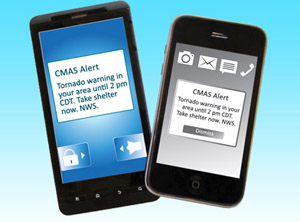Mobile weather warnings on the way!

Imagine this: You’re driving down the highway, humming along to your favorite tunes, when the cell phone stowed in your bag suddenly makes a strange noise. To investigate, you take the next exit and safely pull over to check the screen. Good thing you did: Your phone just alerted you to a tornado a few miles away in the same county you’re driving through.
Sound plausible? It is. This year, America’s wireless industry is rolling out a new nationwide text emergency alert system, called Wireless Emergency Alerts, which will warn you when weather threatens.
The text alert service is free and automatic – there’s no need to sign up or download an app. As long as your cell phone is WEA-capable, you’ll get wireless alerts for the most dangerous types of weather from NOAA’s National Weather Service no matter where you are, just as soon as the new service is available in your area.
NOAA’s NWS will broadcast warnings for weather emergencies that are most dangerous to life and property: tornadoes, flash floods, hurricanes, extreme wind, blizzards and ice storms, tsunamis, and dust storms. (Severe thunderstorm warnings will not be part of the initial rollout of broadcast messages because they are so frequent; however, these will continue to be broadcast by NOAA Weather Radio, media outlets and Internet-based services.)
How weather text alerts work
If you are at home or traveling with your cell phone through an area where a weather warning has been issued, your phone will pick up alerts broadcast by nearby cell towers. Those towers will broadcast the message much like an AM/FM radio station, and cell phones within range will immediately pick up the signal — provided they are WEA-capable. When your phone receives a message, it will alert you with a unique ring tone and vibration.
The message will look like a text, but it’s not a traditional text message most people are used to. This text message will automatically pop up on your cell phone’s screen; you won’t have to open it up to read it.
And there’s more good news: Regardless of where you are, this service will send alerts appropriate to your real-time geographic location. For example, if a person with a WEA-capable phone from New Jersey happens to be in Southern California during and after an earthquake, she will receive an “Imminent Threat Alert” on her device.
 The new weather text alerts issued by NOAA's National Weather Service will include tornado warnings.
The new weather text alerts issued by NOAA's National Weather Service will include tornado warnings.
Download here (Credit: NOAA)
Q: What should I do when I receive a message?
It depends. In most cases, these 90-character messages are a “heads up” to prompt you to seek further information about the threat. In the case of an extreme and imminent danger – such as a large tornado in the area – the message will advise you to seek shelter immediately.
Q: Who is behind the text alert system?
The new weather messages are part of the broader Wireless Emergency Alerts initiative – a partnership among the wireless industry, the Federal Communications Commission (FCC) and the Federal Emergency Management Agency, or FEMA. NOAA’s National Weather Service is one of many agencies authorized to send emergency alerts to cell phones through this new system.
These alerts will improve the way the government communicates to the public about hazards that pose a significant threat to life and property, and help people plan for and stay safe when they are at risk for dangerous situations — even in their own homes. You might also receive messages regarding Amber alerts, local hazards (e.g., chemical spills), and even national emergencies.
The ‘fine print’
The Wireless Emergency Alert system relies on “best-effort” networks, so delivery of alerts at a given place and time is not guaranteed. The new alert system is not a replacement for other alert systems, and you should not rely on it as a sole source of emergency information. A weather alert sent through WEA is intended to notify the public that a warning has been issued and that you should seek additional information. Remember: Not all phones are capable of receiving Wireless Emergency Alerts.
Cell service customers can opt out of weather alerts, but we strongly discourage you from doing so. These weather alerts are a vital public service that ultimately helps America become a more weather-ready nation. Armed with late-breaking weather warnings, people will have the timely information they need to make smart decisions about how to protect themselves, their families, their friends and neighbors, and their personal property.
Find out if your phone is WEA-capable and when the alert system will be available in your area: Contact your wireless carrier today or visit CTIA, the Wireless Association.
Posted June 6, 2012 ![]()





